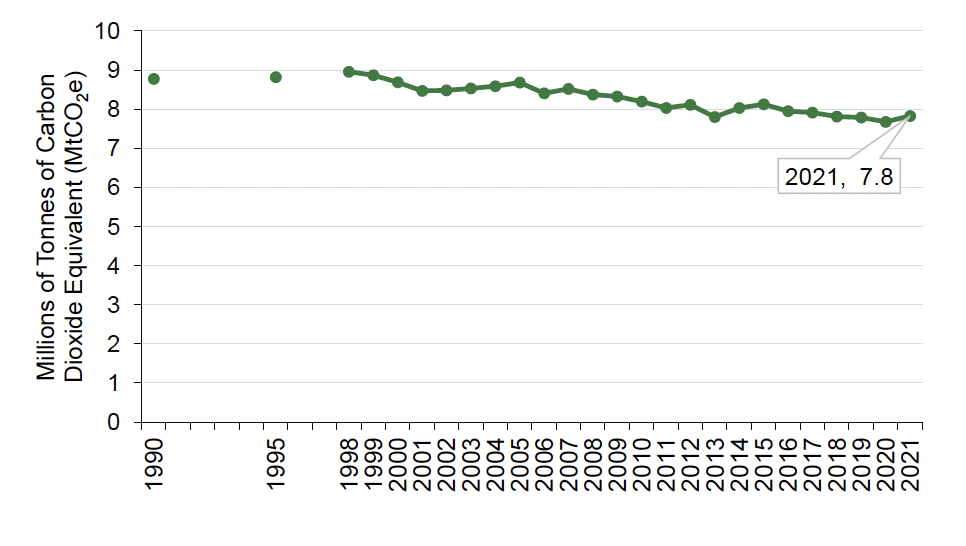Agriculture and Rural Communities (Scotland) Bill: supporting evidence and analysis
This report outlines the current position of the Scottish agricultural sector, with evidence aligned to the objectives in our Vision for Agriculture, and provides information on our approach to assessing new policy proposals as they are taken through secondary legislation.
2.4 Climate Mitigation and Adaption
Agriculture has an important role to play in reducing Scotland’s greenhouse gas emissions. Agricultural greenhouse gas emissions originate from a range of different sources and activities, including but not limited to: enteric fermentation in the digestive system of livestock; manure management; soil emissions; and agricultural machinery. As a result, different farm sectors and farm types inevitably produce different emissions requiring a different approach to emission reductions.
Scottish agriculture generated 7.8 MtCO2e (million tonnes of carbon dioxide equivalent) in 2021, equivalent to 19% of total Scottish emissions. Agricultural emissions have fallen by 0.9 MtCO2e, or 11%, since 1990, which is the base year from which the government’s emission targets are set. This long-term decrease was driven primarily by a decrease in the number of cattle and sheep driven by market factors.

Agriculture is the fourth highest greenhouse gas emitting sector in Scotland, out of the seven Climate Change Plan Update sectors (Figure 8). The reduction in agricultural emissions is smaller than emission reductions recorded across other sectors (Figure 9), and across Scotland as a whole, where total emissions have nearly halved during the same period. The Scottish Government’s Climate Change Plan update requires agricultural emissions to reduce by a further 2.5 MtCO2e to 5.3 MtCO2e by 2032, the equivalent of a 32% reduction from 2021 levels. For context, this means achieving close to triple the reduction in emissions recorded over the past 30 years, in one-third of the time.
Agricultural emissions need to fall by around a third by 2032


As noted in the Update to the Climate Change Plan, agriculture and food production rely on natural processes, and will therefore always cause some degree of greenhouse gas emissions; in particular, ruminant livestock will always emit some greenhouse gases. Therefore, a balance must be found to ensure greenhouse gas reductions can take place while Scotland continues to produce high quality and sustainable food. However, with changes in farming practices, and by utilising new technology and innovative tools, a substantial reduction in emissions can be achieved.Analysis produced for the Scottish Government assessed a wide range of mitigation measures that could be employed in Scotland. This includes measures that provide high emission reduction potential that also save farmers money or cost very little to implement in most scenarios, for example: growing clover-grass mix instead of pure grass; using genomics in dairy breeding; increasing the beef output from dairy herds using sexed semen; finishing beef animals faster; and using nitrate as a feed additive for beef.
Ruminant livestock produces high levels of methane, a particularly potent greenhouse gas, from enteric fermentation, and both methane and nitrous oxide from manure management. It is estimated that the beef, sheep and dairy sectors collectively produce around three-quarters (77%) of total agricultural emissions (Figure 10) while arable farming accounts for a further 19% of total emissions, primarily associated with nitrous oxide from inorganic fertilizer application.

Source: Scottish Government analysis of the greenhouse gas inventory and “Disaggregating headline Smart Inventory figures for Scottish Agriculture” by Andrew Moxey and Steven Thomson
Agriculture also has an important role to play in reducing emissions in the Land Use, Land Use Change and Forestry (LULUCF) sector in the Climate Change Plan Update. This covers emissions and removals of greenhouse gases resulting from direct human-induced land use, land-use change and forestry activities. Just one example of this is the Integrating Trees Network, a farmer and crofter led initiative showcasing the multiple benefits of increasing the integration of trees on farmland for climate change and wider environmental priorities.
The soil can sequester, or capture and store, atmospheric carbon dioxide. Through a process called photosynthesis, carbon dioxide is fixed into plants. When the plant dies, it decomposes and the carbon it fixed becomes part of the soil organic matter. Estimates of the additional carbon storage potential of Scottish soils are highly uncertain and extremely variable across geographical area, land use and soil type. It is estimated that there is the potential to store an additional 60 mega tonnes of carbon in Scottish topsoils under grassland soils and 88 mega tonnes of carbon in topsoils under arable land. But there is also the risk that up to 112 mega tonnes of stored soil organic carbon could be lost. Scottish soils generally have high soil organic carbon contents, so it may be difficult to further increase the carbon content of Scottish soils under current land use practices.
Climate change is also a severe risk to the agricultural sector. The Farm Advisory Service notes that summers have become hotter and drier, winters milder and wetter, and heavy rainfall events have increased in frequency. Extreme weather events have become less predictable but far more intense. These changes are having a number of impacts on Scottish agriculture in areas such as productivity, soil quality, pests and diseases, water availability and quality, and flooding. Some parts of Scotland's agricultural sector are expected to experience some positive changes, however, in most cases these are largely outweighed by the negative impacts.
Contact
Email: richard.haw@gov.scot
There is a problem
Thanks for your feedback